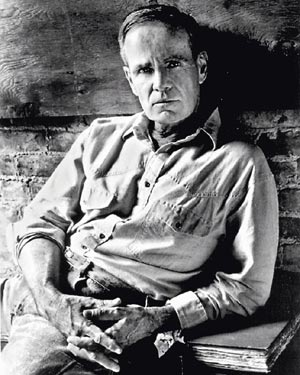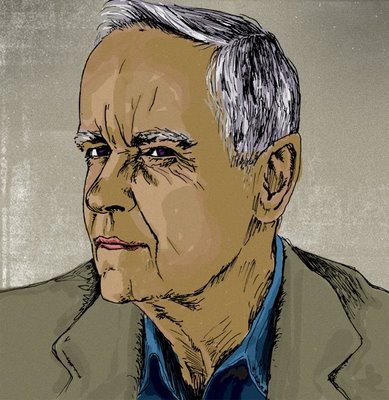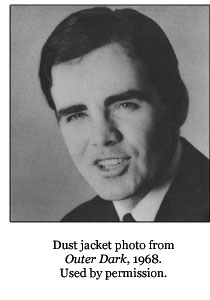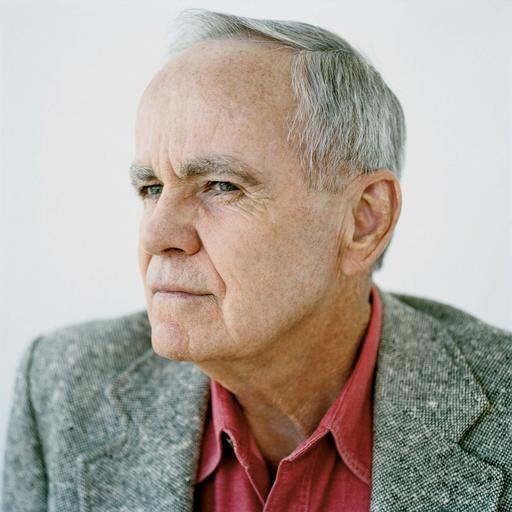A Biography
Cormac McCarthy was born in Rhode Island on July 20, 1933. He is the third of six children (the eldest son) born to Charles Joseph and Gladys Christina McGrail McCarthy (he has two brothers and three sisters). Originally named Charles (after his father), he renamed himself Cormac after the Irish King (another source says that McCarthy’s family was responsible for legally changing his name to the Gaelic equivalent of “son of Charles”).
In 1937, when he was four, the family moved to Knoxville, and his father became a lawyer for the Tennessee Valley Authority (legal staff 1934-67; chief counsel 1958-67). In 1967, the McCarthys moved from Knoxville to Washington, D.C., where Charles was the principal attorney in a law firm until his retirement.
Cormac was raised Roman Catholic. He attended Catholic High School in Knoxville, then went to the University of Tennessee in 1951-52. His major: liberal arts. McCarthy joined the U.S. Air Force in 1953; he served four years, spending two of them stationed in Alaska, where he hosted a radio show.
From 1957-59, McCarthy returned to the university, where he published two stories, “A Drowning Incident” and “Wake for Susan” in the student literary magazine, The Phoenix, calling himself C. J. McCarthy, Jr. While at the university, he won the Ingram-Merrill Award for creative writing in 1959 and 1960.
McCarthy left the university again, this time for good. He went to Chicago, where he worked, apparently as an auto mechanic, while writing his first novel. He later married Lee Holleman, who had been a student at the University of Tennessee, and the couple settled in Sevier County, Tennessee. They had one son, Cullen. Some time later, their marriage ended. (Lee McCarthy is the author of several books of poetry, including Desire’s Door.)
Before his first novel, The Orchard Keeper, was published (1965—McCarthy’s editor at Random House was Faulkner’s long-time editor, Albert Erskine), McCarthy had received a traveling fellowship from the American Academy of Arts and Letters. In 1965, using this money, he left America on the liner Sylvania, intending to visit the home of his Irish ancestors (a King Cormac McCarthy built Blarney Castle). While on the trip, he met Anne DeLisle, a young English singer/dancer working on the ship; they were married in England in 1966. Another grant was given McCarthy in 1966, a Rockefeller Foundation Grant (1966-68). He and Anne toured southern England, France, Switzerland, Italy, and Spain. Then they settled on the island of Ibiza, which was a kind of artist’s colony at the time. Here, McCarthy completed revisions of Outer Dark.
In 1967, though, possibly at Anne’s urging, the McCarthys returned to America. They moved to Rockford, Tennessee, a town near Knoxville. According to Anne, the McCarthys lived in a rented house ($50 per month—to live at a pig farm). Outer Dark was published by Random House in 1968. The reviews were again good, as they had been for The Orchard Keeper.
1969 saw the arrival of another fellowship, this time the Guggenheim Fellowship for Creative Writing. He and his wife moved into a barn near Louisville, Tennessee. McCarthy renovated the barn himself—entirely. Anne states that he added, among other things, a stone room and chimney. All the stones he gathered, all the wood he cut and kiln dried himself. Additionally, for his new fireplace, McCarthy salvaged bricks from the boyhood home of James Agee, which was being leveled to make way for downtown urban renewal in Knoxville.
Child of God was published in 1973. Inspired by actual events in Sevier County, it garnered mixed reviews, some praising it as great, while others found it despicable.
From 1974-75, McCarthy worked on the screenplay for a PBS film called The Gardener’s Son, which premiered in January 1977. This screenplay, too, was based on actual historical events; the locale was South Carolina. A revised version of the screenplay was later published by Ecco Press.
Anne DeLisle and Cormac McCarthy were separated in 1976 (no children), and McCarthy moved soon after to El Paso, Texas, where he lived for many years. They were divorced a few years later.
In 1979, McCarthy published his fourth novel, Suttree, a book which had occupied his writing life on and off for twenty or so years. It was said by many to be McCarthy’s best work to date, and some critics still maintain that it is his finest novel. However, the book drew some negative reviews, too. At least one reviewer (who wrote for the Memphis Press Scimitar) was roundly rebuked in a letter to the editor written by novelist and historian Shelby Foote.
1981 brought another grant to McCarthy’s door (or, more literally, to McCarthy’s room in a motel run by a friend in Knoxville), this time a MacArthur Fellowship—one of their so-called genius grants. McCarthy used this money to live on while writing his next novel, an apocalyptic western set in Texas and Mexico during the 1840s and based heavily on actual historical events.
Blood Meridian was published in 1985, but received little review attention at the time. Now, however, it is considered a turning point in his career. Some critics prefer his recent western writing, of which Blood Meridian was the first example. Others feel that he has strayed too far from his roots, that his westerns lack something. But Blood Meridian, followed closely by Suttree, is now generally regarded as McCarthy’s finest work to date. McCarthy did extensive research for the novel. The author visited all the locales of the book and even learned Spanish to further his research.
After the retirement of Albert Erskine, McCarthy moved from Random House to Alfred A. Knopf. There, under the editorial advisement of Gary Fisketjon, McCarthy began to get exposure. In connection with the book’s publication and as a favor to his retiring editor Albert Erskine, he granted The New York Times Magazine the sole interview [link requires registration] to which (at that time) he had ever submitted. All the Pretty Horses, the first volume of The Border Trilogy, was published by Knopf in 1992. Unlike McCarthy’s earlier books, this one became a publishing sensation, garnering many excellent reviews. It became a New York Times bestseller, and sold 190,000 copies in hardcover within the first six months of publication. It finally gave McCarthy the wide readership that had eluded him for many years.
McCarthy used the money he had made from All the Pretty Horses to buy a new pickup truck. He kept on writing.
McCarthy edited and revised a play he had written in the mid-1970s, which was published in the summer of 1994 by Ecco Press. Called The Stonemason, the tragedy explores the fortunes of three generations of a black family in Kentucky. Shortly after the publication of The Stonemason, Knopf released the second volume of The Border Trilogy, The Crossing. It began life with a first printing of 200,000 copies, a large printing for a work of literary fiction. Sales were brisk enough to justify the second printing of 25,000 more copies before the end of the first month after publication. The book features the tale of Billy Parham’s attempt to return a trapped she-wolf to its home in the northern Mexican mountains and the tragic consequences of his adventure.
The third volume of The Border Trilogy was published in 1998; Cities of the Plain unites John Grady Cole, the main character of All the Pretty Horses, with The Crossing‘s Billy Parham, and centers on Cole’s doomed relationship with a Mexican prostitute. Not as well-received by critics as the first two books in the Border Trilogy, Cities of the Plain is nonetheless notable for its epilogue, which reaches back to Suttree in its imagery and simultaneously casts the entire Border Trilogy in a new and fascinating light, unifying the previous two volumes of the trilogy.
Sometime around the publication of Cities of the Plain, McCarthy married for a third time; he and his wife Jennifer Winkley have one child, John Francis, born 1999. The McCarthys have also moved from El Paso; they now reside in Tesque, New Mexico, on the outskirts of Santa Fe. McCarthy has taken a position as writer in residence with the Santa Fe Institute.
2005 brought the publication of No Country for Old Men, which was adapted into an award-winning film by Joel and Ethan Coen.
In 2006, Alfred A. Knopf published The Road, which won the Pulitzer Prize for Literature. McCarthy granted an interview with Oprah Winfrey, who had chosen The Road for her Book Club. The Road was awarded the 2007 Pulitzer Prize in Literature, and it also won the James Tait Black Memorial Prize for fiction.
The Sunset Limited arrived in 2006. Commissioned by Chicago’s Steppenwolf Theater, it premiered in May, with publication thereafter. The play takes place in a shabby tenement apartment, where Black (a former convict) and White (a university professor) discuss “big questions” about God, faith, life, and death following Black’s saving White, who had attempted to commit suicide by jumping in front of an oncoming subway train. HBO subsequently produced a successful adaptation of The Sunset Limited starring Samuel L. Jackson and Tommy Lee Jones (directed by Jones).
Early 2012 brought the announcement that McCarthy had penned an original screenplay, The Counselor. Little is currently known about the screenplay, but Ridley Scott has been attached to direct. The story apparently deals with territory and themes similar to that explored in No Country for Old Men.
Except for a few odds and ends (his favorite novel is Melville’s Moby-Dick; he doesn’t care for the work of Henry James, he doesn’t like to talk about writing, etc.), that’s more or less what we know about Cormac McCarthy.
The Cormac McCarthy Society respects the author’s clearly expressed desire for privacy. If you wish to contact him, please write to Mr. McCarthy care of his agent:
c/o Amanda Urban
International Creative Management
730 Fifth Ave.
New York, NY 10019
(212) 556-5600




